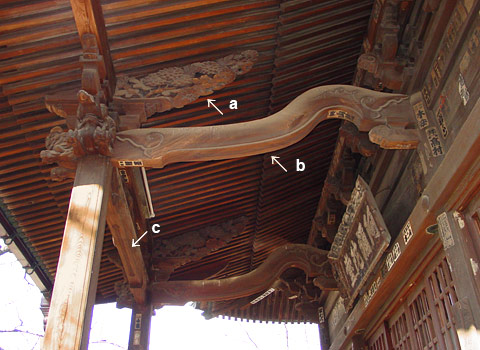|
||
 |
||
An usually-shaped rainbow tie beam thought to resemble the back of a lobster or shrimp or an s-shape turned on its side `. It is used in the aisles *hisashi ù, surrounding the core *moya ê®, of a temple or shrine, building when the pillars of the core and the hisashi vary in height. Ebikouryou are used on each side of a step-canopy *kouhai üq to join the pillars at the bottom of the steps to the head-penetrating tie beams *kashiranuki ªÑ that are inserted into the tops of the pillars that form the outer framework of the building. Ebikouryou were one of the characteristic structural members of the Zen style *zenshuuyou T@l, introduced in the early 13c. Although found mainly in Zen style temple buildings, it was also imitated in wayou style *wayou al buildings. Originally the curvature of the ebikouryou was slight but gradually it became exaggerated. An early example is found at Kouzanji Butsuden ÷R§a (1320), Yamaguchi prefecture; and a late example at Unpouji Hondou _ô{° (late Muromachi period), Yamaguchi prefecture.

a)
*tabasami è²@b) ebikouryou CVøÀ@c) *kashiranuki ªÑ
Yuutenji Amidadou SV¢íÉ° (Tokyo)
Yuutenji Amidadou SV¢íÉ° (Tokyo)
@
(C)2001 Japanese Architecture and Art Net Users System.@No reproduction or republication without written permission.
fÚÌeLXgEÊ^ECXgÈÇASÄÌRec̳f¡»E]ÚðֶܷB

